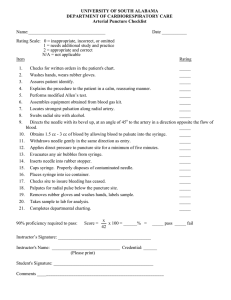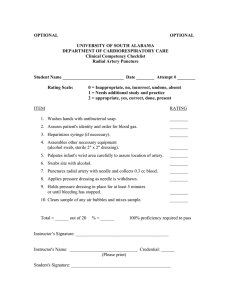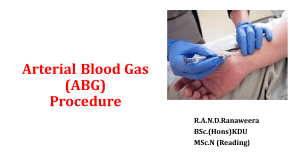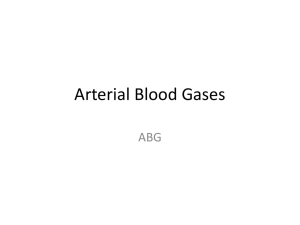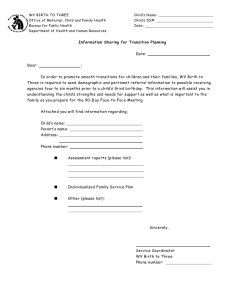Document 14645463
advertisement
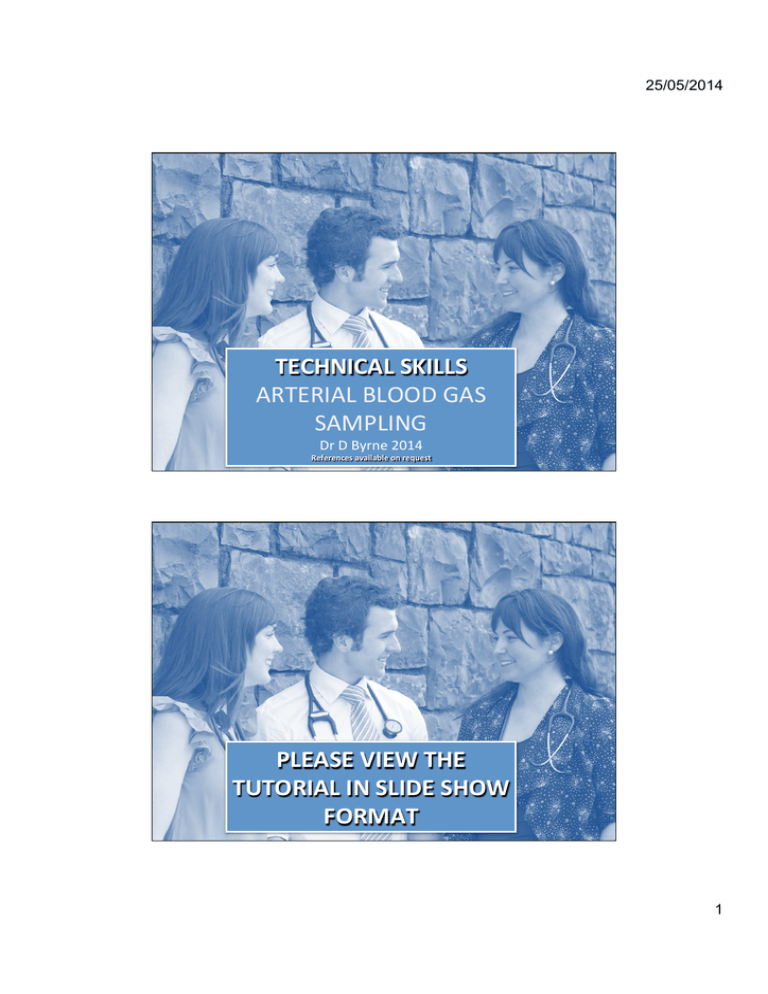
25/05/2014 TECHNICAL SKILLS ARTERIAL BLOOD GAS SAMPLING Dr D Byrne 2014 References available on request PLEASE VIEW THE TUTORIAL IN SLIDE SHOW FORMAT 1 25/05/2014 LEARNING OBJECTIVES At the end of this tutorial you should be able to: 1. List the indica@ons for an arterial blood gas sample (ABG). 2. Perform an ABG from the radial artery. 3. Demonstrate knowledge of the equipment used. 4. Consent the pa@ent. 5. Document the procedure. 6. Recognise and deal with any complica@ons. TUTORIAL OUTLINE Indica@ons for an ABG Equipment selec@on Pa@ent contact/consent Equipment & Pa@ent Prepara@on Procedure Steps Complica@ons FAQs 2 25/05/2014 INDICATIONS Key ConsideraKons: The aim of an ABG is to give you more informa@on regarding acid-­‐base homeostasis of the pa@ent at the @me of the puncture. It is the only reliable determinant of ven@la@on success as evidenced by CO2 content. It is a good measurement of successful gas exchange and oxygena@on. In general it is used in very ill pa@ents, pa@ents with metabolic acidosis, respiratory failure and ven@lated pa@ents. However it is a test that has some risks associated with it and you should ask yourself how necessary is this test prior to performing it. INDICATIONS To iden@fy acid-­‐base disorders. To monitor acid-­‐base status. To measure CO2 levels. To monitor ven@lated pa@ents. To assess respiratory failure. 3 25/05/2014 EQUIPMENT SELECTION Remember to observe hand hygiene with gel before you select your equipment. (See Tutorial on hand hygiene) Clean your equipment with alcohol wipes. (phlebotomy tray) EQUIPMENT You Will Need The Following: • Phlebotomy Tray • Sharps Bucket • Non Sterile Gloves • A few mediswabs/alcohol wipes 4 25/05/2014 EQUIPMENT You Will Also Need : • A few blood gas sampling needles • Some Co[on Wool Balls & Tape • A Small Hand Towel (if available) EQUIPMENT Place all items on the clean Phlebotomy Tray 5 25/05/2014 EQUIPMENT The ABG Sampling Needle and Syringe: This is a prefilled heparanised syringe along with a protec@ve safety shield and a syringe cap. The plunger should be le^ depressed to allow the arterial blood flow to fill the syringe. Allow to fill to a minimum of 2mls. PATIENT CONTACT/CONSENT Remember: Observe hand hygiene with gel upon entering the pa@ent’s cubicle/room. Introduce yourself and explain the procedure and complica@ons. This is informed verbal consent. 6 25/05/2014 PATIENT CONTACT/CONSENT Say: “Hello Mr O Neill, my name is Dr. Barry and I am here to take a blood sample from your wrist. It is a sample of blood from the artery to measure the amount of oxygen in your blood. It is a liEle uncomfortable but it is a safe procedure. If I am unable to obtain a sample from you, I may have to try the other wrist ,with your permission or I may have to ask for help. You may get some bruising aHer the procedure (especially if the paIent is on anIcoagulants) and in order to avoid this I will ask you to apply pressure to the artery aHer I take the blood. There is a small chance of damage to the artery and for this reason I would like to perform a test on your wrist to check if both your arteries are open.” EQUIPMENT & PATIENT PREPARATION Remember: Observe hand hygiene with gel before preparing your equipment. There is very li[le prepara@on. If using tape and co[on balls, it is easier to tear off pieces of tape now before you have your gloves on. Roll the pa@ent’s sleeve up above their an@cubital fossa and look at the arm. Palpate the radial artery as puncture of the radial artery is preferable. Perform Allen’s test to clinically assess adequacy of ulnar artery collateral flow (see next slide). Posi@on their hand on a firm surface so that the wrist is in 40 degrees extension. Place a small rolled up towel under the wrist to make the pa@ent comfortable. 7 25/05/2014 EQUIPMENT & PATIENT PREPARATION Allen’s Test: 1. Pa@ent elevates their hand. 2. Pa@ent clenches fist several @mes to blanch palmar skin. 3. Firm occlusive pressure applied on both radial and ulnar artery. 4. Release ulnar artery while the radial artery is compressed. 5. Note the @me for palmar capillary refill. 7. Repeat the test with radial artery release first. PROCEDURE STEPS Wash your hands and apply non sterile gloves. (See Tutorial No.2 ‘Hand Hygiene’) 8 25/05/2014 PROCEDURE STEPS Step 1. Palpate the artery again using your index finger and middle finger. You will be inser@ng the needle between the two points.You may need to mark that point with a skin marker Clean the area with a mediswab/alcohol wipe. PROCEDURE STEPS Step 2. Open the ABG needle packet Uncap the needle. With the bevel facing upwards (towards the heart), insert the needle as close to 90 degrees as possible between your fingers. Advance the needle very slowly un@l the arterial blood starts to fill the syringe. There is no need to withdraw the plunger. Allow to fill to between 2 – 2.5 mls. 9 25/05/2014 PROCEDURE STEPS Step 3. Simultaneously withdraw the needle and place the co[on ball over the puncture site. Apply pressure on the site immediately. PROCEDURE STEPS Step 4. Instruct the pa@ent to apply pressure to the co[on ball for 5 minutes. Meanwhile, close the safety cap on the needle. Remove the needle from the syringe and dispose in the sharps bucket. Expel the air from the syringe. Place the cover/cap on the syringe and sample. 10 25/05/2014 PROCEDURE STEPS Step 5. Gently mix the sample by rolling between your hands PROCEDURE STEPS Step 6. Label the bo[les at the bedside and confirm the pa@ent’s details. Step 7. A^er 5 minutes, check the puncture site and cover with a fresh co[on ball and tape. 11 25/05/2014 PROCEDURE STEPS Step 8. • Remove gloves and dispose of clinical waste into a yellow bag. • Wash hands. • Process sample in the ABG machine immediately, label printout with pa@ent’s details and percentage of oxygen that they were on at the @me of sampling.. PROCEDURE STEPS Step 9. Document in the notes. 12 25/05/2014 COMPLICATIONS Haematoma To avoid this puncture only the uppermost wall of the artery by advancing the needle slowly into the artery. Do not perform on pa@ents with a severe coagulopathy and cau@on should be exercised in pa@ents on warfarin or heparin. Apply pressure to the site immediately a^er puncture and advise the pa@ent to maintain pressure for 5 minutes. Vessel Damage/Occlusion Perform Allen’s test to ensure patency of ulnar artery. To avoid artery damage, insert needle as close to 90 degrees as possible. Pain ABG sampling can be painful if the needle penetrates deep and touches the periosteum of the radial styloid. To avoid this, remember that the radial artery is superficial at the wrist and advance the needle slowly and wait for the syringe to fill. FAQs Q. What happens if I cannot palpate the radial artery? Ans: Try the other wrist. You may have to use the brachial artery or the femoral artery. As an intern you should only do this under supervision and knowing the anatomy of the regions. Q. The pa@ent is on Aspirin. Is this a contraindica@on? Ans: No. Remember to apply pressure and observe for bleeding. Q. The pa@ent has severe peripheral vascular disease. Can I perform ABG sampling on them? Ans: No. 13 25/05/2014 FAQs Q. The pa@ent has an abnormal Allen’s test. What should I do? Ans: Document your findings in the pa@ent’s chart and try the other radial artery. Otherwise get senior help. Q. Do I need to fill the syringe? Ans: No. 2 -­‐2.5mls is sufficient. The ABG machine requires between 0.5 and 1 ml to process a sample. Remember that you will have to expel air from the sample and you may need to reprocess the sample. Q. My pa@ent has an AV fistula. Can I perform an ABG on that arm? Ans: No, not without consul@ng the consultant in charge of the pa@ent. Other areas to avoid are scar @ssue, burns or if there is a skin infec@on in the area. Thank you We hope that you enjoyed the presentaKon. Thanks to the interns in Network West Northwest for their help and enthusiasm. 14
